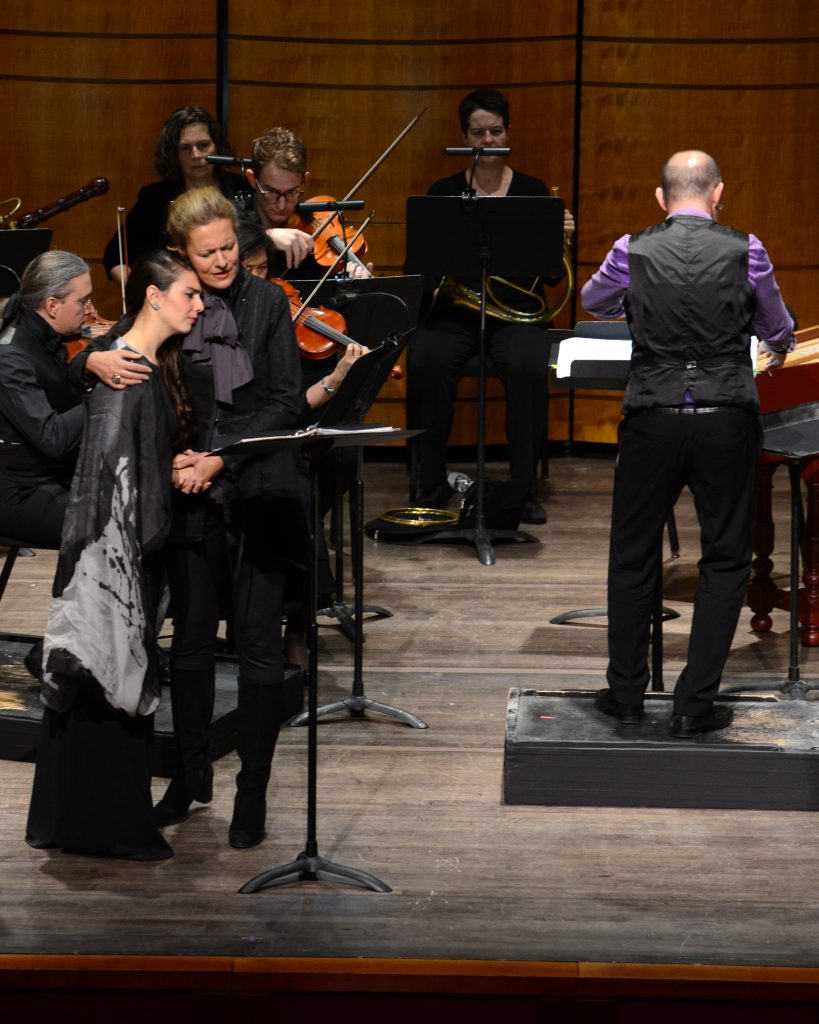Opera Lafayette unearths Neapolitan rarity in amiable season opener

Laetitia Grimaldi and Stephanie Houtzeel perform with Charles Brink conducting Opera Lafayette’s performance of Jommelli’s “Cerere placata.” Photo: Russell Hirshorn
Grandfathers like to bestow generous gifts for the birth of a grandchild. Charles III, King of Spain, gave his granddaughter, the future Empress Maria Theresa of Naples, a lavish performance of a court opera in 1772.
Opera Lafayette presented the first modern revival of the work, Cerere placata, by Niccolò Jommelli, Sunday evening in the Kennedy Center Terrace Theater. Flutist Charles Brink was guest conductor for this concert performance of the new edition he had prepared. Even without the dance music, the evening ran to three hours of opera.
The story is not quite what you may think based on the title of “Ceres Placated.” Ceres here is Queen of Sicily, where the goddess of agriculture had a major shrine. Her daughter, Proserpina, has been carried off, not by the god of the underworld, but by Titano, King of Spain. The couple, who have eloped over her mother’s objections, are shipwrecked on Sicily, where the implacable queen insists on sacrificing Titano in the temple. Only the intervention of Jupiter, by the ridiculous rules of opera seria, placates the angry mother, ushering in a happy ending.
Laetitia Grimaldi’s spitfire soprano lit up the hall as Proserpina, limpid and floating in her opening aria in Act I but also able to articulate runs delicately and precisely in her subsequent fast music. The most delectable moments of the opera came in her duets with the equally extraordinary mezzo-soprano Stephanie Houtzeel as Titano, a role created by the castrato Giuseppe Aprile. Houtzeel imbued every line of accompanied recitative, an extensive part of Jommelli’s style, with drama and force, interpolating some impressive high notes into the cadenza of her opening aria.
In the title role Jennifer Casey-Cabot deployed an acerbic soprano bite as the angry mother, including powerful top notes fired off with devastating accuracy. As Ceres’ rage grew and festered, Casey-Cabot chewed the non-existent scenery to portray it. (Mozart, who likely knew this opera and set the text of one of its arias to his own music, may have thought of this aggrieved harridan’s vituperations when he created the Queen of the Night.)
Light tenor Thomas Michael Allen struggled with the upper range in his first aria but was generally effective as the bemused, befuddled counselor Alfeo, earning some of the evening’s biggest laughs. Arianna Zukerman was resolute as the High Priest, her clear-toned soprano cutting through the choral numbers, which the soloists helped cover with bass Andrew Adelsberger.
Patrick Kilbride hammed up the role of deus ex machina, descending the stairs in a spotlight as Giove at the end. Carrying a microphone, the tenor seemed like a game show host, prophesying the lineage of King Charles III to be engendered from the marriage of Proserpina and Titano.
Charles Brink conducted in a basic, foursquare fashion and ensemble cohesion suffered because of a lack of clarity in his gestures. Brink was not able to keep the orchestra on pace with singers in a couple places, which caused some confusion, most notably in one of Houtzeel’s melismatic passages. The orchestra’s volume also overwhelmed the singers too often, leading to some strained sounds.
The orchestra of historical instruments was in fine form for the most part. The two oboists, Caroline Giassi and Luke Conklin, acquitted themselves admirably in the extended overture, where an extended section for twin oboes unspooled beautifully. The natural horns, surrounded by a pile of crooks to adjust to different key signatures, were appropriately rustic, and Brink’s one contribution on flute, played from the podium, was delicate in tone.
The only instrumental shortcoming was in the continuo, where a couple lapses took some time to recover, most notably in a dialogue between Titano and Alfeo. All in all, however, this was a noteworthy rediscovery, another reminder of that often-forgotten Neapolitan link between early Italian baroque and classical opera.
Cerere placata will be repeated 7:30 p.m. Tuesday in New York. operalafayette.org
